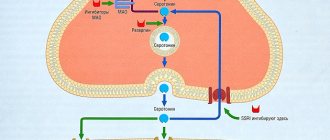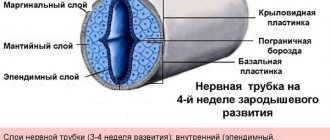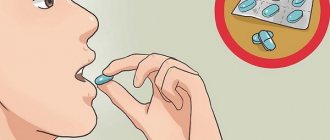Modern therapy for neurological diseases is complex and aimed at various stages of development of the pathological process, as well as at eliminating the symptoms of damage to the nervous system.
Principles of vitamin therapy
Vitamins (especially B vitamins) are extremely important for the normal functioning of both the central and peripheral nervous systems.
These include, first of all, compounds such as:
- Vitamin B 1 – thiamine. It is indispensable in the processes of intracellular metabolism, prevents “cellular aging”, having antioxidant activity, and helps normalize the conduction of nerve impulses. With a deficiency of the vitamin, which is observed in chronic alcoholism, Wernicke encephalopathy can develop, a condition characterized by high mortality.
- Vitamin B 6 – pyridoxine. Its task is the regulation of protein metabolism in the cells of the nervous system, the utilization of protein breakdown products, and a number of processes in the synthesis of neurotransmitters.
- Vitamin B12 – cyanocobalamin. It is sometimes called a "growth factor." Its task is to participate in many processes occurring in the peripheral and central nervous systems: regulation of methionine synthesis and hereditary “memory” - nucleic acids.
The use of vitamins in the treatment of many neurological diseases can reduce treatment time. The use of vitamins is possible using different ways of entering them into the body.
ul
Pharmacological characteristics of vitamin preparations
The least effective, but at the same time the most pleasant way is to take it orally (through the mouth), in the form of pills. Despite all the advantages, this method has significant drawbacks: when absorbed into the blood, substances pass through the liver, and quantities that may not have a therapeutic effect may enter the bloodstream. Despite various attractive names (neuromultivitis), the effectiveness of such drugs is not high enough. At least, there is not a single recorded case where taking “vitamins” cured severe neurological pain. This is, in principle, possible, but in the conditions of a clinic of severe vitamin deficiency. Thus, a decoction of rose hips worked wonders against scurvy - a deficiency of vitamin C, raising people to their feet in a few days.
The second, most popular way of administering vitamin preparations for the treatment of neuralgia is through intramuscular injections. Modern medicine has combined vitamin preparations for intramuscular administration. People of the older generation, visiting a neurologist in the last century, remember how 2-3 injections were given at the same time, since vitamins could not be mixed in one syringe. Currently, there are such remedies, for example, Milgamma Compositum - a combination of several B vitamins in one syringe. There are many similar drugs, for example, Combilipen, Neurobion, Trigamma and many others. Their use in complex therapy of neuralgia of various origins has shown sufficient effectiveness, much greater than the use of oral medications.
However, getting directly into the systemic bloodstream, vitamins, although they do not pass through the liver and are not influenced by its microsomal system and the cytochrome system, but, evenly distributed in the bloodstream, do not have an end point of application to a specific place.
A way out of the situation is provided by the third, most advanced method of administering vitamins for the treatment of neuralgia - electrophoresis.
The essence of electrophoresis is that, under the influence of an electric field, vitamin molecules penetrate through the skin and tissue directly into the area that needs treatment. In some cases, the simultaneous administration of multivitamins intramuscularly is justified, alternating them with sessions of electrophoresis of the area that is the source of painful impulses.
Vitamin preparations are certainly necessary in the treatment of most neuralgia. The main thing is to use them in combination when they have an auxiliary effect. For example, taking vitamins allows you to reduce the doses of other medications, such as non-steroidal anti-inflammatory drugs. In this case, the risk of overdose, frequency and severity of side effects are reduced.
Recommended reading
- What is the difference between neuralgia and osteochondrosis?
- Neuralgia as a possible sign of malignancy
- Neuralgia - what is it?
- What is the difference between neuralgia and neurology, what is the difference?
ul
Principles of vitamin therapy
Vitamins (especially B vitamins) are extremely important for the normal functioning of both the central and peripheral nervous systems.
These include, first of all, compounds such as:
- Vitamin B 1 – thiamine. It is indispensable in the processes of intracellular metabolism, prevents “cellular aging”, having antioxidant activity, and helps normalize the conduction of nerve impulses. With a deficiency of the vitamin, which is observed in chronic alcoholism, Wernicke encephalopathy can develop, a condition characterized by high mortality.
- Vitamin B 6 – pyridoxine. Its task is the regulation of protein metabolism in the cells of the nervous system, the utilization of protein breakdown products, and a number of processes in the synthesis of neurotransmitters.
- Vitamin B12 – cyanocobalamin. It is sometimes called a "growth factor." Its task is to participate in many processes occurring in the peripheral and central nervous systems: regulation of methionine synthesis and hereditary “memory” - nucleic acids.
Well-known vitamin B-12
The use of vitamins in the treatment of many neurological diseases can reduce treatment time. The use of vitamins is possible using different ways of entering them into the body.
Contraindications
Neurotropic vitamins are suitable for almost all categories of patients, even pregnant women, nursing mothers, children, and the elderly. Restrictions on taking tablets and performing injections are most often associated with hypersensitivity to the components. Some vitamin complexes are not suitable for expectant mothers or children under a certain age.
There are a sufficient number of people with increased sensitization of the body who react negatively to B vitamins. After taking tablets or injections, a pronounced immune reaction sometimes develops. For this reason, allergy patients need to be careful when taking cyanocobalamin, riboflavin, biotin, folic acid, and pyridoxine.
Advice!
Before taking the combination drug or injection for the first time, you need to prepare an antihistamine tablet. A fast-acting remedy, for example, Suprastin, is required to eliminate possible allergic manifestations in the event of a negative perception of the vitamin complex by the body.
Pharmacological characteristics of vitamin preparations
The least effective, but at the same time the most pleasant way is to take it orally (through the mouth), in the form of pills. Despite all the advantages, this method has significant drawbacks: when absorbed into the blood, substances pass through the liver, and quantities that may not have a therapeutic effect may enter the bloodstream. Despite various attractive names (neuromultivitis), the effectiveness of such drugs is not high enough. At least, there is not a single recorded case where taking “vitamins” cured severe neurological pain. This is, in principle, possible, but in the conditions of a clinic of severe vitamin deficiency. Thus, a decoction of rose hips worked wonders against scurvy - a deficiency of vitamin C, raising people to their feet in a few days.
The second, most popular way of administering vitamin preparations for the treatment of neuralgia is through intramuscular injections. Modern medicine has combined vitamin preparations for intramuscular administration. People of the older generation, visiting a neurologist in the last century, remember how 2-3 injections were given at the same time, since vitamins could not be mixed in one syringe. Currently, there are such remedies, for example, Milgamma Compositum - a combination of several B vitamins in one syringe. There are many similar drugs, for example, Combilipen, Neurobion, Trigamma and many others. Their use in complex therapy of neuralgia of various origins has shown sufficient effectiveness, much greater than the use of oral medications.
However, getting directly into the systemic bloodstream, vitamins, although they do not pass through the liver and are not influenced by its microsomal system and the cytochrome system, but, evenly distributed in the bloodstream, do not have an end point of application to a specific place.
A way out of the situation is provided by the third, most advanced method of administering vitamins for the treatment of neuralgia - electrophoresis.
The photo shows electrophoresis, one of the ways to introduce vitamins into the body
The essence of electrophoresis is that, under the influence of an electric field, vitamin molecules penetrate through the skin and tissue directly into the area that needs treatment. In some cases, the simultaneous administration of multivitamins intramuscularly is justified, alternating them with sessions of electrophoresis of the area that is the source of painful impulses.
Vitamin preparations are certainly necessary in the treatment of most neuralgia. The main thing is to use them in combination when they have an auxiliary effect. For example, taking vitamins allows you to reduce the doses of other medications, such as non-steroidal anti-inflammatory drugs. In this case, the risk of overdose, frequency and severity of side effects are reduced.
General rules of application
To achieve a positive effect in diseases of the spine, muscles, joint and cartilage tissue, doctors recommend a combination of several types of vitamins. The treatment regimen is developed by a vertebrologist, neurologist or orthopedic traumatologist.
- in case of exacerbation, severe pain, it is important to receive (injections, tablets), injections of neurotropic vitamins. A course of powerful painkillers and anti-inflammatory drugs - from 3 to 7 days;
- after the inflammatory process subsides, combination agents with pyridoxine, thiamine and cyanocobalamin are prescribed. Some formulations contain an analgesic - lidocaine. The use of vitamin complexes suppresses pain and improves nervous regulation. The average duration of treatment is 10-14 days;
- the next stage is support for cartilage and bone structures, nervous tissue, and blood vessels. Patients with spinal hernia, osteochondrosis, myalgia, neuralgia, sciatica, and other diseases are prescribed vitamin and mineral supplements. Active components: phosphorus, calcium, selenium, magnesium, ascorbic acid, retinol, tocopherol. Calcium supplements can be taken only after passing a biochemical blood test. Duration of therapy - 30-60 days;
- after the pain has decreased for six months or more, the patient takes. This type of preparation is useful only if part of the elastic cartilage pad is preserved. In severe cases, intervertebral hernia, destruction of the fibrous ring, taking chondroprotectors does not bring noticeable results: there is practically no tissue for restoration.
Deficiency of neurotropic B vitamins negatively affects the functioning of the central nervous system and peripheral nerves. Doctors recommend taking combined formulations in the form of tablets for many orthopedic pathologies, cerebral complications, and neuralgic diseases of the back and spine. It is important to take into account the limitations and choose a vitamin complex with the optimal composition.
From the following video you can learn instructions for using a vitamin B complex in tablets called Neurovitan:
About 5% of all people and 20% of older people are deficient in vitamin B. Most strict vegetarians are also at risk of B deficiency. However, not only vegetarians and the elderly need them. It turns out that multivitamin supplements are one possible way to reduce occupational stress and improve productivity. Another important benefit of taking them is reducing the risk of cardiovascular disease. Our pharmacies sell many complexes.
There are contraindications, consult a specialist
What groups of vitamins should you take for neuralgia?
A deficiency of vitamins in the body, especially group B, is one of the additional causes of neuralgia - an inflammatory process of nerve endings.
In medical practice, neuralgia of the occipital, sciatic, and trigeminal nerves is most often encountered. Neuralgia of the back is common due to diseases of the spine and intercostal.
Vitamins for neuralgia are included by the doctor in complex therapy along with medication and massage aimed at supporting the functioning of the nervous system.
Features of the disease and principles of vitamin therapy for pathology
If you feel sudden pain in the hypochondrium, you should not immediately think of heart problems. Perhaps this is one of the types of neuralgia. The thing is not very pleasant, but quite curable. The main thing is to visit a doctor in a timely manner and begin treatment so that the disease does not become chronic.
Neuralgia manifests itself as paroxysmal or aching pain in the areas where certain nerves connect. In places where nerve endings accumulate, there may be tingling, burning and numbness.
Neurological pain can be localized in any part of the body and have various underlying causes:
- hypothermia of the body;
- inflammation;
- injuries;
- infections;
- diseases of the nervous system;
- poisoning;
- allergies;
- reduced immunity;
- stress and nervous overload.
Hypothermia is a possible cause of neuralgia.
The most common diseases of peripheral nerves are trigeminal neuralgia and intercostal neuralgia. With trigeminal nerve disease, pain is concentrated in the face. The patient reacts to the slightest touch to the nose or cheek. Cold and hot food, brushing teeth, loud sounds or flashes of light also cause discomfort in the patient. Damage to the trigeminal nerve can be caused by facial trauma, inflammation of the sinuses, or untreated teeth.
Intercostal neuralgia occurs due to a disease of the spine, in particular its thoracic region. It manifests itself as sharp pain in the ribs when sighing, coughing, sneezing, turning or bending the body.
The therapeutic regimen prescribed by a medical specialist may include the following medications:
- analgesic;
- anti-inflammatory;
- warming (ointments and creams).
For the effectiveness of treatment and a speedy recovery, vitamins are mandatory among other medications. It is generally accepted that taking vitamins for serious neuralgia is useless. However, this is wrong. They stop inflammation, increase the body's defenses and help it get back into shape faster.
Therapy using vitamins for neurological pathologies is characterized by the following principles that must be followed during treatment. Features of vitamin therapy:
- Complex treatment - vitamins should be taken together with other medications.
- Methods of using vitamins - in tablets or injections. The effectiveness of these methods varies. During therapy, the severity and extent of the disease should be taken into account. When prescribing the drug by injection, you cannot independently replace it with pills. This will not lead to the expected result.
- Doses of vitamins can only be determined by the attending physician, based on test results.
In case of neurological pathologies, you should not self-medicate. When dealing with the nervous system, you need to understand the seriousness of the disease and the need for a qualified approach to solving health problems.
The essence of vitamin therapy
Vitamin therapy in medicine is used both for the treatment and prevention of various diseases of internal organs, skin pathologies, and nervous disorders. In the treatment of neurological disorders it has the following effects:
- allows to reduce treatment time;
- strengthens weakened immunity;
- provides the basis for restoring the functioning of the nervous system and joints;
- helps to weaken toxic manifestations and reduce doses of a number of medications used in treatment;
- increases the effectiveness of certain medications;
- reduces the intensity of pain.
At the same time, vitamins can enter the human body in various ways:
- Orally (tablets, capsules, dragees, syrups). The simplest and least stable method of administration. When absorbed, beneficial substances pass through the liver, from where only a small amount is effectively absorbed into the blood, which is insufficient to provide a therapeutic effect.
- Intramuscular injections of combined vitamin preparations. They are more efficient compared to the first method. However, getting directly into the systemic bloodstream, vitamins, although they do not pass through the liver and are not influenced by its microsomal system and the cytochrome system, do not have an end point of delivery to the sore spot.
- Electrophoresis is a method in which vitamin molecules, under the influence of an electric field, penetrate through the skin and tissue directly into the area in need of treatment (lower back or cervical region).
List of necessary vitamin preparations
Getting enough vitamins into the body (especially group B) is extremely important for the normal functioning of both the central and peripheral nervous systems.
Water-soluble B vitamins, which contain nitrogen in their molecules, play an important role in cellular metabolism.
They are also responsible for energy metabolism, maintain a normal digestive system, increase resistance to stress, help stabilize blood sugar levels, and complement the treatment of anemia, neurological and psychiatric conditions. The activity of the immune system and the efficiency of cell growth and reproduction processes largely depend on the presence of these vitamins.
For neuralgia, it is recommended to take the following medications:
- B1 - thiamine - “vitamin of good spirits”. It has a positive effect on brain function, is indispensable in the processes of intracellular metabolism, prevents cellular aging, improves memory characteristics, has antioxidant activity, and helps normalize the conduction of nerve impulses.
- B6 - pyridoxine. Its task is to regulate protein metabolism in the cells of the nervous system, reduce mood swings, utilize protein breakdown products, and a number of processes in the synthesis of neurotransmitters.
- B12 is cyanocobalamin (another name is “growth factor”). Participates in many processes occurring in the peripheral and central nervous systems, including the biosynthesis of the protective sheath of nerve fibers.
Vitamin therapy is carried out against the background of a diet rich in protein, since it retains useful substances in the body.
In addition, to increase the effectiveness of vitamin therapy, you should adhere to the general principles of a healthy diet:
- avoid spicy, fatty, salty foods;
- exclude any alcoholic drinks from the diet (they aggravate inflammation);
- introduce a ban on processed foods, instant food and fast food.
All these products can cause metabolic failure and insufficient absorption of vitamins B and E, which are necessary for nerve cells.
To ensure a sufficient supply of useful substances to the body, you can not only drink medicines, but also add to the menu the following natural sources of compounds necessary for life:
- Vitamin B12 - lean meats, seafood (mussels, herring), low-fat dairy products (including cheese), eggs.
- Thiamine - bread and flour products (due to the yeast content), cereals, peanuts, cottage cheese.
- B6 - melon, tomatoes, citrus fruits, potatoes and sweet potatoes, peppers, spinach leaves, grain sprouts, walnuts and hazelnuts, meat.
B vitamins in the complex treatment of facial pain
November 6, 2020
Facial pain, which includes pain on the surface of the face and/or in the mouth (orofacial pain), is a fairly common type of pain. Most often, orofacial pain manifests itself as acute dental pain, which usually regresses after dental treatment.
However, in a number of cases, facial pain itself (prosopalgia) is noted, manifested by chronic or recurrent pain, often resistant to various methods of conservative treatment.
A kind of primacy in severity belongs to trigeminal facial pain, especially trigeminal neuralgia and deafferentation trigeminal neuropathy, during exacerbation of which the severity of pain is many times greater than the intensity of acute toothache familiar to most people.
Prosopalgia is caused by various pathological processes that lead to chronic irritation of the sensory fibers of the cranial nerve or its autonomic ganglion (inflammation, trauma, compression of nerves in congenitally narrow or pathologically altered canals and openings of the skull bones).
Exacerbation of prosopalgia is facilitated by circulatory disorders, hypothermia, infectious and allergic diseases, endogenous and exogenous intoxications, metabolic disorders, and vitamin deficiencies.
Dysfunction of the central antinociceptive system with the formation of an irritative focus of pathological activity also plays a role in the pathogenesis of the disease.
There are neurogenic and somatogenic prosopalgia. Typical neurogenic prosopalgia are considered to be neuralgia of the trigeminal, glossopharyngeal and vagus nerves. They are characterized by repeated short-term attacks of pain and the presence of trigger zones.
Atypical neurogenic prosopalgia includes vegetalgia, cranial neuropathies, vascular and psychogenic prosopalgia, as well as prosopalgia that develops with organic diseases of the central nervous system.
The problem of treating prosopalgia is the sufficient persistence and duration of the pain syndrome, which entails the development of psycho-emotional disorders, since it mainly affects the working-age population, and as a result, a decrease in the quality of life.
Traditionally, the treatment of pain syndromes in most cases begins with nonsteroidal anti-inflammatory drugs (NSAIDs).
The ineffectiveness of traditional analgesics prescribed in connection with the development of trigeminal facial pain is an indication for the use of drugs from other groups, in particular carbamazepine, gabapentin or amitriptyline, which have analgesic activity in a number of forms of prosopalgia.
Also, to activate regenerative processes in peripheral nerves, neurotropic complexes containing large doses of B vitamins (B1, B6, B12) are used. It is well known that B vitamins significantly influence the processes occurring in the nervous system (metabolism, metabolism of mediators, transmission of excitation).
Clinical experience shows that parenteral use of a combination of thiamine, pyridoxine and cyanocobalamin relieves pain well, normalizes reflex reactions, and eliminates sensitivity disorders.
Therefore, for pain syndromes, including the face, doctors often resort to using vitamins of this group, both as monotherapy and in combination with other drugs. A sufficient number of studies indicate clinical improvement with the use of B vitamins in patients with pain of various localizations.
However, many questions regarding the use of a combination of B vitamins in the treatment of facial pain syndromes remain open.
In therapeutic doses, B vitamins affect the state of metabolism and energy exchange of neurons, the production of mediators, the transmission of excitation in the nervous system, etc.
Vitamin B1 (thiamine), being a coenzyme of decarboxylases and transketolases, eliminates acidosis caused by excessive accumulation of pyruvic and lactic acids, which reduce the threshold of pain sensitivity; suppresses the processes of lipid peroxidation, reducing the negative impact of the latter on the structural and functional state of the nerve fiber.
Thiamine activates ion channels in neuronal membranes, enhances endothelium-dependent vasodilation and improves endoneurial blood flow, increases the energy supply of neurons and supports axonoplasmic transport of proteins. These effects of vitamin B1 promote the processes of regeneration of nerve fibers.
Vitamin B6 is a cofactor for a number of enzymes of amino acid metabolism and is involved in the metabolism of proteins and amino acids, lipid metabolism and energy production in cells.
By activating the synthesis of the myelin sheath of nerves and transport proteins in the axial cylinders of nerve fibers, pyridoxine helps accelerate the regeneration of peripheral nerves, thereby exhibiting a neurotropic effect.
The antinociceptive effect of the vitamin is realized through restoration of the synthesis of a number of mediators - serotonin, dopamine, norepinephrine, GABA and activation of descending inhibitory serotonergic pathways (antinociceptive system), which leads to a decrease in pain sensitivity.
Vitamin B12 is involved in the synthesis of purines and pyrimidines, which play an important role in the processes of regeneration of nervous tissue; in the formation of methionine and S-adenosylmethionine, necessary for the production of neurotransmitters and phospholipids; accelerates nerve regeneration by activating the synthesis of lipoproteins necessary for the construction of cell membranes and the myelin sheath; reduces the release of excitatory neurotransmitters (glutamate), has hematopoietic, antianemic and metabolic effects.
The effectiveness of the complex drug is due to the complementary antinociceptive and neurotropic actions of all three B vitamins, which contributes to the inhibition of nociceptive impulses and has a positive effect on the processes of regeneration of axons and the myelin sheath of the trigeminal nerve. Restoring the structure of the trigeminal nerve and its branches leads to a balanced passage of afferent flows of impulses of different modalities through them.
Thus, the strategy of complex neurotropic, neurometabolic and analgesic pharmacotherapy for trigeminal neuralgia and other types of facial pain will optimize therapeutic regimens and improve the prognosis.
Prepared by Tatyana Antonyuk
Facial pain, which includes pain on the surface of the face and/or in the mouth (orofacial pain), is a fairly common type of pain. Most often, orofacial pain manifests itself as acute dental pain, which usually regresses after dental treatment.
However, in a number of cases, facial pain itself (prosopalgia) is noted, manifested by chronic or recurrent pain, often resistant to various methods of conservative treatment.
A kind of primacy in severity belongs to trigeminal facial pain, especially trigeminal neuralgia and deafferentation trigeminal neuropathy, during exacerbation of which the severity of pain is many times greater than the intensity of acute toothache familiar to most people.
Prosopalgia is caused by various pathological processes that lead to chronic irritation of the sensory fibers of the cranial nerve or its autonomic ganglion (inflammation, trauma, compression of nerves in congenitally narrow or pathologically altered canals and openings of the skull bones).
Exacerbation of prosopalgia is facilitated by circulatory disorders, hypothermia, infectious and allergic diseases, endogenous and exogenous intoxications, metabolic disorders, and vitamin deficiencies.
Dysfunction of the central antinociceptive system with the formation of an irritative focus of pathological activity also plays a role in the pathogenesis of the disease.
There are neurogenic and somatogenic prosopalgia. Typical neurogenic prosopalgia are considered to be neuralgia of the trigeminal, glossopharyngeal and vagus nerves. They are characterized by repeated short-term attacks of pain and the presence of trigger zones.
Atypical neurogenic prosopalgia includes vegetalgia, cranial neuropathies, vascular and psychogenic prosopalgia, as well as prosopalgia that develops with organic diseases of the central nervous system.
The problem of treating prosopalgia is the sufficient persistence and duration of the pain syndrome, which entails the development of psycho-emotional disorders, since it mainly affects the working-age population, and as a result, a decrease in the quality of life.
Traditionally, the treatment of pain syndromes in most cases begins with nonsteroidal anti-inflammatory drugs (NSAIDs).
The ineffectiveness of traditional analgesics prescribed in connection with the development of trigeminal facial pain is an indication for the use of drugs from other groups, in particular carbamazepine, gabapentin or amitriptyline, which have analgesic activity in a number of forms of prosopalgia.
Also, to activate regenerative processes in peripheral nerves, neurotropic complexes containing large doses of B vitamins (B1, B6, B12) are used. It is well known that B vitamins significantly influence the processes occurring in the nervous system (metabolism, metabolism of mediators, transmission of excitation).
Clinical experience shows that parenteral use of a combination of thiamine, pyridoxine and cyanocobalamin relieves pain well, normalizes reflex reactions, and eliminates sensitivity disorders.
Therefore, for pain syndromes, including the face, doctors often resort to using vitamins of this group, both as monotherapy and in combination with other drugs. A sufficient number of studies indicate clinical improvement with the use of B vitamins in patients with pain of various localizations.
However, many questions regarding the use of a combination of B vitamins in the treatment of facial pain syndromes remain open.
In therapeutic doses, B vitamins affect the state of metabolism and energy exchange of neurons, the production of mediators, the transmission of excitation in the nervous system, etc.
Vitamin B1 (thiamine), being a coenzyme of decarboxylases and transketolases, eliminates acidosis caused by excessive accumulation of pyruvic and lactic acids, which reduce the threshold of pain sensitivity; suppresses the processes of lipid peroxidation, reducing the negative impact of the latter on the structural and functional state of the nerve fiber.
Thiamine activates ion channels in neuronal membranes, enhances endothelium-dependent vasodilation and improves endoneurial blood flow, increases the energy supply of neurons and supports axonoplasmic transport of proteins. These effects of vitamin B1 promote the processes of regeneration of nerve fibers.
Vitamin B6 is a cofactor for a number of enzymes of amino acid metabolism and is involved in the metabolism of proteins and amino acids, lipid metabolism and energy production in cells.
By activating the synthesis of the myelin sheath of nerves and transport proteins in the axial cylinders of nerve fibers, pyridoxine helps accelerate the regeneration of peripheral nerves, thereby exhibiting a neurotropic effect.
The antinociceptive effect of the vitamin is realized through restoration of the synthesis of a number of mediators - serotonin, dopamine, norepinephrine, GABA and activation of descending inhibitory serotonergic pathways (antinociceptive system), which leads to a decrease in pain sensitivity.
Vitamin B12 is involved in the synthesis of purines and pyrimidines, which play an important role in the processes of regeneration of nervous tissue; in the formation of methionine and S-adenosylmethionine, necessary for the production of neurotransmitters and phospholipids; accelerates nerve regeneration by activating the synthesis of lipoproteins necessary for the construction of cell membranes and the myelin sheath; reduces the release of excitatory neurotransmitters (glutamate), has hematopoietic, antianemic and metabolic effects.
The effectiveness of the complex drug is due to the complementary antinociceptive and neurotropic actions of all three B vitamins, which contributes to the inhibition of nociceptive impulses and has a positive effect on the processes of regeneration of axons and the myelin sheath of the trigeminal nerve. Restoring the structure of the trigeminal nerve and its branches leads to a balanced passage of afferent flows of impulses of different modalities through them.
Thus, the strategy of complex neurotropic, neurometabolic and analgesic pharmacotherapy for trigeminal neuralgia and other types of facial pain will optimize therapeutic regimens and improve the prognosis.
Prepared by Tatyana Antonyuk
Source: //neuronews.com.ua/ru/issue-article-1593/Vitaminy-gruppy-Vv-kompleksnom-lechenii-licevoy-boli
What medications are most effective in treating neuralgia?
In the treatment of pain caused by pinched nerve roots as a result of muscle spasms, various diseases of the spine, stressful situations, hypothermia, hernial protrusions, tumors, medications for neuralgia are prescribed. Their list includes various groups of pharmaceuticals characterized by a wide spectrum of action.
Neuralgia is a serious disease that requires timely treatment when the first signs of a painful attack appear. Timely seeking help from a qualified specialist provides an opportunity to avoid aggravation of the situation, difficulty breathing, clouding of consciousness, and the development of complications.
Ointments and gels
Remedies for neuralgia in the form of ointments and gels quickly relieve pain. They instantly penetrate through the skin pores into the deep tissues, to the lesion, reduce the severity of the pain syndrome and eliminate swelling.
External agents stimulate blood circulation, distract from pain, and relieve nervous tension. Thanks to them, blood supply to the sore spot improves, nutrition of damaged tissues, and pain goes away.
To treat intercostal neuralgia use:
- Fastum-gel. The product relieves pain, stimulates blood flow, and eliminates swelling.
- Capsicam. The ointment, due to its effective warming effect, accelerates the supply of blood to tissues. It restores tissue trophism and helps replenish nutrients.
- Finalgon. The ointment warms up. Thanks to it, blood vessels dilate. Blood flow increases. Oxygen and nutrients enter the tissues.
- Indomethacin, Ortofen, Naklofen, Ibuprofen. Ointments fight inflammation, swelling and pain.
- Menovazin. The ointment has a pronounced analgesic effect.
- Chondroxyl. The chondroprotector restores mobility to the spine.
Preference is given to ointments. Their rate of penetration into tissue is higher than that of gels. In the early stages and for severe pain, ointments are used that can relieve muscle spasms and relax muscles.
For patients suffering from severe pain, try not to prescribe ointments with a burning effect. By increasing stimulation at the site of the lesion, it is possible to provoke the development of an ischemic crisis or heart attack due to excessive outflow of blood from the coronary vessels.
Features of drug therapy in the treatment of neuralgia
Drug therapy is in first place in the treatment regimen for acute pain attacks caused by pinched nerve endings in various areas of the human body. Prescribing medications for neuralgia involves achieving certain goals. These include:
- reducing the intensity of pain caused by pinched nerve roots;
- adjustment of treatment after the removal of combat syndrome, aimed at improving metabolic processes in nerve fibers;
- achieving anti-inflammatory, stabilizing, analgesic, sedative, analgesic effect;
- strengthening the immune system, which determines the protective functions of the human body;
- restoration of the activity of nerve endings after relief of pain, their stimulation
- preventing relapse of neuralgia;
- increasing the content of vitamins, minerals, microelements in the patient’s body.
Analgesics to eliminate neuralgia
To effectively solve the problem of pinched nerve roots in different areas of the human body, different groups of pharmacological agents are intended, which differ in their multidirectional action, properties, speed of action on the source of inflammation, and side effects. What medications to take for neuralgia are determined only by the attending physician. The results of diagnostic measures form the basis for their choice. Among the common components of pharmacotherapy that successfully eliminate the manifestations of a pathological condition, as well as effectively eliminate the main causes of its development, it is necessary to note analgesics, which are painkillers. Their action is aimed at relieving painful neuralgic syndrome caused by pinched nerve roots. Painkillers are available in the form of tablets, capsules, creamy substances, ointments, gels, and injection ampoules. A variety of analgesics provide the opportunity to use them externally, orally or as intramuscular injections. The most popular analgesics include: Sedalgin, Baralgin, Spazmalgon, Analgin, Tempalgin, Bral. The use of novocaine and lidocaine blockades allows you to eliminate acute pain that cannot be treated with tablets and topical agents. Painkillers are recommended to be used for 3-4 days. Longer use of analgesics can lead to inflammation of the gastrointestinal tract.
NSAID medications
Pharmacy products NSAIDs are non-steroidal drugs characterized by a pronounced anti-inflammatory effect. With their help, it is possible to localize neuralgic syndrome, reduce the intensity of pain and attacks, and significantly improve the general condition of patients faced with a disease of the nervous system. Such properties of NSAID drugs, which have the ability to influence not only the inflammatory process, but also the thermal state of the sick person’s body, pain, play an important role in the treatment of pathology.
Drug therapy for neuralgia involves the use of a wide range of medications of this type. The most common of them include: Diclofenac, Ortofen, Ibuprofen, Ketoprofen, Piroxekam, Voltaren, Indomethacin. Such drugs and their analogues are available in the form of tablets and capsules. It is recommended to take them no more than 1-2 times a day. It is strictly forbidden to exceed the dosage prescribed by your doctor. Ignoring the recommendations of a neurologist can lead to the development of diseases of the gastrointestinal tract, including ulcerative conditions of the mucous membranes of the stomach and duodenum, gastritis and other pathologies. The course of drug therapy based on non-steroidal anti-inflammatory drugs is 5-7 days. In addition to the form of tablets and capsules, NSAID drugs are available in the form of rectal suppositories and injections. Ointments, creams, gels, and special patches are produced for external use. These include Diprilif, Voltaren, Ketonal, Nise, Diclofenac and other analogues with a similar composition. When using NSAIDs for external use, it is recommended to handle them carefully, carefully rubbing them into areas of pain, excluding pressing and massaging the inflamed areas. Special patches, which include Ketonal Thermo, are considered a modern alternative to applications with ointments, creams, and gels.
Instructions for use
Currently, there are several pharmaceutical companies producing cobalamins in tablet form. Pharmacists in pharmacies often offer complex preparations containing them. However, the main points in the instructions indicating how to use them are the same.
Beneficial features
Considering the fact that the main active ingredient in the tablets is cobalamin elements, that is, vitamin B12, their beneficial properties are:
- normalization of the process of absorption and oxidation of lipid particles;
- production of essential amino acid substances;
- normalization of the hematopoietic system;
- participation in the process of creating nerve endings such as myelin sheaths;
- reducing the amount of cholesterol deposits;
- protection of the hepatic system from various harmful factors affecting it from the outside;
- normalizing blood pressure levels;
- normalization of sleep and wakefulness;
- prevention of the development of depressive disorders;
- prevention of the development of senile dementia, confusion of thinking;
- strengthening the immune system;
- providing anabolic effects;
- normalization of the reproductive system in men and women.
It is important that the human body receives the required daily dose of cobalamins. So, for adults it is 2.4 mcg, for newborns - from 0.4 to 0.5 mcg, children under three years old - 0.9 mcg, up to eight years old - 1.2 mcg, up to thirteen years old - 1.8 mcg, before reaching adulthood – 2.4 mcg. For pregnant and lactating women, the daily requirement increases to 2.6 and 2.8 mcg, respectively.
Indications for use
Most often, hypovitaminosis B12 occurs in people who want to improve their figure with regular diets and refuse food of animal origin. Indications for prescribing the tablet form of the drug are:
- anemia caused by a lack of vitamin B12;
- weakened immunity, expressed in frequent infectious and bacterial diseases;
- disruption of the functioning of the hematopoietic system;
- hepatitis;
- cirrhosis of the hepatic system;
- alcohol poisoning;
- polyneuritis;
- radiculitis;
- neuralgia;
- presence of phantom pain;
- cerebral palsy;
- Down syndrome;
- multiple sclerosis;
- dermatitis;
- neurodermatitis;
- psoriasis;
- pathologies of the gastrointestinal tract;
- diseases of the renal system.
It is extremely important to use tablets during constant physical and mental stress, at moments when the body must be as resistant to stress as possible.
Contraindications
Contraindications to the use of this form of substances of group B12 are:
- their individual intolerance;
- blockage of blood vessels in the hematopoietic system, which is acute in nature;
- blood cancer;
- excess of glandular cells and erythroid cells in human genetic material.
You should not take medications containing cobalamins on your own if:
- insufficient functioning of the cardiovascular system;
- pregnancy;
- breastfeeding;
- cancer;
- thrombophilia.
How to use?
Most often, experts recommend using one chewable tablet per day. They are either dissolved by placing them under the tongue or taken with food by chewing. The dosage depends on the patient’s condition, as well as on the recommendations of the manufacturer producing the prescribed drug. It is important to remember that there are substances and products with which B12 cannot be used. These include:
- vitamins B1, B2, B6, C;
- salt formations of heavy metals;
- antiepileptic drugs;
- coagulant agents.
If a specialist considers it necessary to use both medications simultaneously, it is better to use them alternating, but not using them within one day. In addition, there are complex preparations where the dosage of “hostile” substances is selected in such a way as not to cause harm to the human body.
Side effects
Side effects when using drugs where the main active ingredients are cobalamins are rare. However, among them they note:
- increased excitability;
- rapid heartbeat, pain in the heart area;
- allergies, manifested in the form of urticaria;
- violation of the metabolism of purine substances;
- hypercoagulability.
If these conditions occur, you should stop taking the medication immediately. It would be useful to visit a doctor, since a person’s condition may require symptomatic therapy.
Is an overdose possible?
The condition of hypervitaminosis B12 usually occurs when:
- constant, uncontrolled use of tablets;
- exceeding the dosage prescribed by the doctor.
Symptomatic overdose can manifest itself in:
- itching of the skin;
- pulmonary edema;
- peripheral vascular thrombosis;
- congestive heart failure.
In extremely rare cases, the development of anaphylactic shock is observed. At the first symptoms of hypervitaminosis, you should abandon the cobalamin-containing drug. Next, you need to consult a doctor, otherwise you may end up in a hospital bed.
Muscle relaxants, vitamin complexes, neuroprotectors
When diagnosing neuralgia, medications intended to relieve muscle spasms play an important role in drug therapy.
They are called muscle relaxants. Their use makes it possible to achieve positive results, significantly reduce the intensity of pain due to relaxation of muscle fibers and reduce the amount of pressure on the affected nerve process, as well as alleviate the patient’s condition. The list of popular muscle relaxants includes: Clonazepam, Baclofen, Sirdalud, Mydocalm, Tizanidine. The treatment course is prescribed by the attending physician. Complexes based on B vitamins are designed to replenish their deficiency in the patient’s body and effectively combat the inflammatory process. The purpose of neuroprotectors is due to their ability to improve and normalize metabolic processes in brain tissue and the peripheral nervous system. Their list includes: Mexidol, Actovegin, Milgama, Neurobion. In addition to the above drugs, ointments based on bee or snake venom, as well as pepper patches, the use of which can produce an excellent effect, deserve the attention and praise of patients.
Drug treatment of pathology with strict adherence to the recommendations and doctor’s prescriptions is the key to a successful solution to the problem of pinched nerve roots, acute pain syndrome, and also to avoid relapse.
Intercostal neuralgia of the chest: symptoms and how to treat
Chest neuralgia appears when nerve endings are pinched between intervertebral discs, when compressed by traumatic bone fragments, tumors, or blood vessels. Identifying the cause resolves the issue of treating thoracic neuralgia.
- Causes of neuralgia What is thoracic neuralgia?
- Intercostal neuralgia
Collecting the patient's medical history makes it possible to determine the traumatic or inflammatory etiological factor in the onset of the disease. Inflammation of the intercostal muscles appears after hypothermia and is expressed by severe pain. An infectious disease requires the use of antibiotics.
Mechanical deformation of the chest may not create symptoms of a neurological disease, but when the nerve is pressed by bone fragments, neuralgia can only be cured by surgery. By removing the obstruction, it is possible to relieve pain and release the pinched nerve.
In women, the cause of chest neuralgia may be hormonal disorders during menopause. In this case, it is necessary to treat the disease by external correction of the disorders. Hormones that a woman lacks are prescribed.
In elderly people, intercostal neuralgia appears due to polyradiculoneuritis (an inflammatory process of many nerve fibers) as a result of brain pathologies:
- Alzheimer's disease;
- Multiple sclerosis;
- Tumors of brain tissue;
- Neurasthenia.
The following factors are favorable for the appearance of neuralgia:
- Previous herpes;
- Aortic aneurysm;
- Prolonged physical activity;
- Hypothermia.
Additional factors of the disease are: metabolic disorders, lack of B vitamins, intestinal colic, hepatitis, gastritis and peptic ulcer.
Shingles creates symptoms that resemble pancreatitis. The herpes virus leads to pathologies of the nerve ganglia. The initial signs of the disease are accompanied by the appearance of red bubbles in the area of the left hypochondrium, in which the pancreas is located. An additional negative factor for neuralgia is wearing tight underwear, which compresses the blood vessels.
There are other causes of the disease, but the factors listed above appear most often.
- Causes of neuralgia What is thoracic neuralgia?
- Intercostal neuralgia
If neuralgia is associated with a pre-existing disease, it must be treated to avoid further damage to the peripheral nerves and begin recovery processes.
In any case, treatment of neuralgia involves taking medications that reduce pain. When treating neuralgia, the following drugs are prescribed:
- injections of painkillers (local)
- muscle relaxants (drugs to relax muscles)
- non-steroidal anti-inflammatory drugs
- hormonal drugs
- B vitamins
Physiotherapy, including the use of ultrasound, infrared and ultraviolet rays, laser, acupuncture and other techniques, can achieve good results in the treatment of neuralgia. In extreme cases, surgical treatment is used.
Useful products for neuralgia
For neuralgia, the patient needs to receive sufficient quantities of vitamin B, E and thiamine. They help strengthen the immune system and prevent various types of inflammatory processes.
It is necessary to add these foods rich in:
- 1 vitamin B12 – lean meats, low-fat dairy products;
- 2 thiamine – bread and flour products, cereals;
- 3 vitamin B6 – melon, potatoes, spinach leaves;
- 4 vitamin E - vegetable oils, nuts, avocados, wheat (its germ), whole grains, eggs, seafood.












